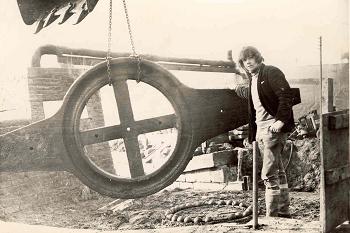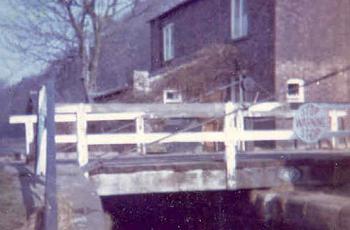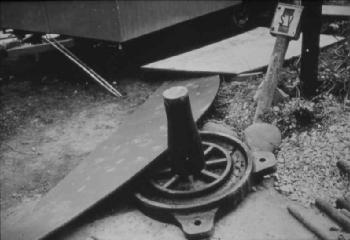Swing bridge 49, Royal Oak, Oakgrove
 Royal
Oak swivel bridge no.49 was one of 13 originally built across the
canal. Most were famers' accommodation bridges, joining divided fields
in the same ownership. Royal Oak was the only swivel bridge to carry
a public highway, and still does. The bridge has had at least three
incarnations. What we believe to have been the original deck served
for c.145 years and required replacement in 1973. We have many pictures
of the works taken at this time showing the construction of
the original bridge (above) and the new bridge, and also the progress
of the work. Royal
Oak swivel bridge no.49 was one of 13 originally built across the
canal. Most were famers' accommodation bridges, joining divided fields
in the same ownership. Royal Oak was the only swivel bridge to carry
a public highway, and still does. The bridge has had at least three
incarnations. What we believe to have been the original deck served
for c.145 years and required replacement in 1973. We have many pictures
of the works taken at this time showing the construction of
the original bridge (above) and the new bridge, and also the progress
of the work.

The original turntable bearing[1] |

The original bridge just prior to demolition,
particularly showing one of two cast iron pillars with
wheel on top carrying the bridge support stays[2] |

Showing the then (1973) BW standard
pintle prior to installation[3] |
Notes very kindly submitted by John Powell, retired British
Waterways Bridge Engineer.
The casting [top right] for the Royal Oak Swing Bridge
No.49 is massive compared with the original drawing for Bridge
No.47, I presume problems with strength had been experienced
at some time in the past and measures taken to improve matters?
The picture [centre right] shows the Cast Iron King
Post with wheel which would have been as originally built,
the chain going over the wheel on the original drawing for
Bridge No.47 is only about 6 inches long, so it is in all probabilty
there, but difficult to see on the photograph.
The 1973 reconstruction of Royal Oak was undertaken
by R.J. Russell & Co. Ltd., Civil Engineering Contractors,
for the sum of £13,461.00 and I can confirm that the
pintle shown in your photograph [bottom right] is the standard
BW pintle being used at that time. It had been improved over
the old cannon ball pintle [top right] by the incorporation
of the vertical post which sits between two transverse beams
with a collar assembly fixing the post firmly to the deck.
The vertical post can now transfer any horizontal forces from
either traffic braking on the deck or boats hitting the side
of the bridge, when previously these forces could only be taken
by friction and resulted in deck movement.
Unfortunately this pintle was unable to cope with the rotational
movement of the bridge beams under modern day traffic loading
and it eventually was replaced with a new pintle with a
single block with a domed upper surface, this was undertaken
in 1986 and the opportunity was taken to power operate the
bridge. This resulted in a conflict between boaters and road
traffic and in 1988 Road Barriers were added in the interest
of public safety.
Bridge 49, Royal Oak, is heavily used by road traffic and
has been fitted with a new deck - timber base with modern wearing
surface - in January 2012.
Operation is electro-hydraulic and carried out by the boater
using the CRT key in the adjacent control box. The controls
require the presence of the operator throughout the process
which can take up to ten minutes. The operator should ensure
the boat is approaching the bridge before operation which will
begin by lowering the road barriers and closing the highway
to vehicular traffic. This is followed by the hydraulic removal
of the support wedges from beneath the bridge. Only then will
the bridge swing. It will automatically stop when it reaches
the fully open position. Once the boat or boats have passed
through, the close button is depressed and the above process
is reversed. When the barriers are fully up, permitting traffic
flow to resume, the key may be removed from the control panel.
Acknowledgement
- John Powell, archive research. John is a retired BW Engineer.
Pictures
1 Macclesfield
Canal Society Heapy collection
2 Macclesfield
Canal Society Heapy collection
3 Macclesfield
Canal Society collection
|